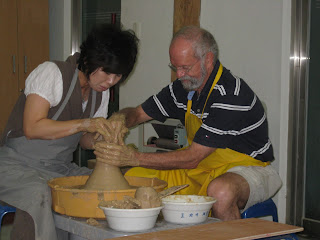

This morning we woke up to the sound of rain. The night we spent in the Korean hotel was very exciting. It was a wonderful once and a life time adventure. On the way to breakfast we got to experience an eye-opening ride on the tour bus. We traveled on very narrow roads that were not much wider than the bus. We ate breakfast in a tented resturant. We were served a fried egg and chicken rice porridge with several sides such as spiced jalapenos, kimchi... Again we were served water from one of the many water coolers located throughout South Korea. We were also offered a cup of instant coffee. Not only can you get cold water out of one side of the cooler but you can also get hot water out of the other side. Those coolers come in mighty handy! After breakfast we had a pottery class. We each made a piece of pottery that is characteristic of Korean culture using a pottery wheel. As you may already know the process of finishing a piece of pottery takes several days. They offered to ship us our final products once they are finished.
After lunch we went to visit a Buddhist Temple. On our way up the mountain to the temple, we by chance met and took pictures with the mayor of Yeongiu. He was very gracious and interested in hearing about our expeiences in Korea. We found out that one of his ancestors was involved in producing the Korean Alaphabet. A common thread throughout the trip has been the way we have been recieved by the Korean people. They have a very welcoming air about them that is very sincere.
The temple was located high on the top of a mountain. It had breathe taking views. The buildings were beautifully constructed. We witnessed a couple of different ceremonies going on.
After the temple we rode back once again to our traditional Korean hotel to pick up our luggage. Then we took a three hour bus ride back to Daegu. A bus ride might sound bad but actually it was very comfortable. It was a bus limo and we had reclining seats. We were also the only people on the bus so we had plenty of room to stretch out. Arriving in Daegu we pulled up to a Five Star Hotel! We were each given our own room! After dropping off the luggage in or rooms and cleaning up, we were treated to a huge buffet. To say the least we were treated like royalty and very thankful to Ajin!
After lunch we went to visit a Buddhist Temple. On our way up the mountain to the temple, we by chance met and took pictures with the mayor of Yeongiu. He was very gracious and interested in hearing about our expeiences in Korea. We found out that one of his ancestors was involved in producing the Korean Alaphabet. A common thread throughout the trip has been the way we have been recieved by the Korean people. They have a very welcoming air about them that is very sincere.
The temple was located high on the top of a mountain. It had breathe taking views. The buildings were beautifully constructed. We witnessed a couple of different ceremonies going on.
After the temple we rode back once again to our traditional Korean hotel to pick up our luggage. Then we took a three hour bus ride back to Daegu. A bus ride might sound bad but actually it was very comfortable. It was a bus limo and we had reclining seats. We were also the only people on the bus so we had plenty of room to stretch out. Arriving in Daegu we pulled up to a Five Star Hotel! We were each given our own room! After dropping off the luggage in or rooms and cleaning up, we were treated to a huge buffet. To say the least we were treated like royalty and very thankful to Ajin!


































